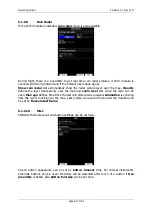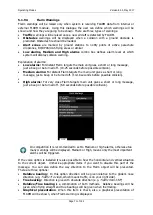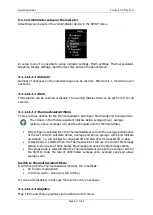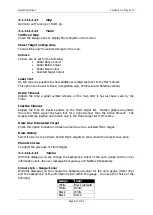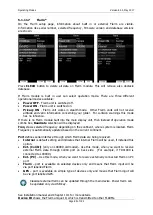
Operating Modes
Version 6.03, May 2017
Page 76 of 192
Set TE compensation to 100%. Accelerate up to approximately 160 km/h (75 kts) and keep
the speed stable for a few seconds. Gently reduce the speed to 80 km/h (45 kts). Observe
the vario indicator during the manoeuvre. At 160 km/h the vario will indicate about –2 m/s
(-4 kts). During the speed reduction the vario should move towards zero and should never
exceed zero (slightly positive indications are acceptable). If the vario shows a climb the
compensation is too low; increase the TE%; and vice versa. Try another “zoom” to assess
the change and make further adjustments if necessary.
Digital TE compensation is only effective when the Pitot tube and static sources are co-
located and the pneumatic lines to the instrument are approximately the same length. The
best sensor to use is the combined Pitot/static Prandtl tube. If problems are experienced
with the digital TE compensation the most likely cause is the glider's static source. The
static source can be checked by plumbing the pneumatic tubes for digital TE compensation
and then setting the TE: to 0%. In still air accelerate to approximately 160 km/h and slowly
reduce the speed. Observe the vario indicator. If the static source is good the vario should
immediately start to move to show a climb. If the needle firstly shows increased sink and
then moves to a climb, the static source of the glider is unsuitable and there is no way to
provide successful digital TE compensation. The use of a dedicated and accurate fin-
mounted Pitot/static source such as a Prandtl tube might help.
5.1.11.1.2
Temperature Offset
The system is supplied with an external outside air temperature (OAT) sensor. With the
offset setting it will correct static errors of temperature measurement.
There is another input called VARIO PRIORITY. When this input is activated by
grounding the appropriate wire the unit will change over to Vario immediately.
This input wire is set open (not grounded) as a factory default on delivery.
5.1.11.1.3
Airspeed Offset
Some gliders are having quite big difference between calibrated airspeed and indicated
because of imperfect static ports (e.g.: Cirrus Standard). As airspeed effects wind
calculation. It is possible to define an airspeed offset to improve wind calculation.
Vario indicator will ignore this setting and shows not corrected airspeed.
5.1.11.1.4
Digital inputs
V9 or V5 variometer is having six programmable digital inputs. Two of them a bit special and
are labelled VP and SC (since August 2015 SC is no more wired via cable), others are
labelled with IN1, IN2, IN3 and IN4 on V5/V9 cable-set. See Installation manual for more
details on vario unit wiring diagram.
In current version digital input can represent the state of following actions:
SC on/off switch
is used to change between SC (cruise) and climb mode using
on/off switch on remote stick of magnetic switches on flaps. Use
invert
check box to
invert working of switch.
SC toggle button
is used to change between SC (cruise) and climb mode using
push button on remote stick. Use
invert
check box to toggle when button is pressed
down or released.
Vario priority
is used to instantly change from SC (cruise) to climb mode as long as
push button is pressed.
Gear down and locked
should be connected to gear only.
Airbrakes locked
should be connected to airbrakes only.

